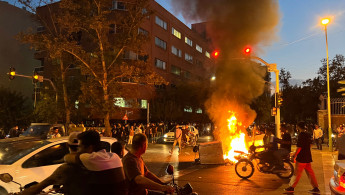Iran hijab protests: What is happening and how did it begin?
Protests against Iran's mandatory hijab law erupted in recent days after the death in custody of Mahsa Amini, a 22-year-old Kurdish-Iranian woman who was detained last week by religious police in Tehran for not fully covering her hair.
Several cities in Iran have witnessed large-scale protests over the past few days demanding an end to the morality laws and morality police, who are accused of beating Amini into a coma in detention.
Chants of "Death to the morality police" - playing on the pro-government slogan of "Death to America" - and "women, life, freedom" have been heard at protests.
Police and military have brutally suppressed some of the demonstrations, particularly in Iran's Kurdish region where Amini was from, with five protesters killed on Monday according to rights groups.
Many women have removed their headscarves and burned the Iranian flag in protest, as anger over strict social restrictions and police brutality rises.
Police have met the protesters with tear gas, batons, and arrests as authorities desperately try to quell growing resentment of the regime among the youth of Iran.
How did it start?
Mahsa Amini was arrested at a metro station in Tehran last Tuesday accused of breaking so-called morality laws, which require women to fully cover their hair and arms.
Iran's police have launched a crackdown on what they call "immodest dress" following the election of conservative Ebrahim Raisi as president.
Amini was taken to a detention centre by religious police where she was to be "educated" on the morality laws. Shortly after arriving, she went into a coma, allegedly after receiving blows to her head.
What happened?
Witnesses said they saw Amini being beaten in a police van on her way to the detention centre.
Police claim the 22-year-old died of a heart attack, but her family insists there were signs of bruising to her body indicating torture.
Police also released CCTV footage of the incident, which shows her clutching her face and then falling to the ground.
Amini's father claims the footage was edited and that she had no preexisting medical issues. She died on Friday, three days after she was hospitalised.
An Iranian medical official backed the family's statements and said Amini most likely died from a blow to the head, pointing at assault by officers.
How have authorities responded?
There has been anger at the response from authorities to the incident.
Police Brigadier General Hossein Rahimi denied the "cowardly accusations" that Amini was beaten and rejected any wrongdoing by officers.
Interior Minister Ahmad Vahidi claimed the 22-year-old had a history of medical issues and religious police "basically do not have the tools to beat the detainees". Her family has rejected this claim and said the 22-year-old was fit and healthy before she was detained.
ℹ️ Update: Four protesters are reported killed in #Iran's Kurdish region as authorities open fire and impose a ~3.5 hour regional internet blackout. The incident follows partial disruptions in Tehran and other cities from Friday #Mahsa_Amini
— NetBlocks (@netblocks) September 19, 2022
📰 Report: https://t.co/8cCHIJAADQ pic.twitter.com/e5EUZIw0Bq
Iranian security forces have brutally repressed demonstrations against her death, including at Amini's funeral where gunfire was reportedly used against protesters.
Authorities have also restricted Internet coverage in some parts of the country in a bid to quell the unrest.
Why are Iranians protesting?
Iranians have been shocked by Amini's death, blaming the notorious religious police for her killing. More widely, there has been growing resentment, particularly among the young, about the economic situation in Iran, as well as tight political and social restrictions.
People have been angered at the authorities' denial that police were involved, calling for the officers involved in her detention to stand trial.
There have been calls for the religious police to be abolished, so-called modesty laws to be overturned, and even an end to Iran's theocratic system of government.
Many of the protests have been marked by women removing their headscarves, sometimes burning them, in a sign of rebellion against the strict conservative laws of the country.
Men have also joined in, some shaving their heads in a sign of solidarity with women and in memory of Amini who was "killed for showing her hair", as some tweets have said.
Iranians are shaving their hair in the respect and mourning for #Mahsa_Amini #مهسا_امینی because she was killed just for her hair. pic.twitter.com/UX2lK5bbo0
— دلقک (@saybyetomeee) September 19, 2022
In several cities, protesters clashed with security forces and prevented police from making arrests.
On Monday evening protests continued with further unrest expected this week despite a growing crackdown by Iran's notorious security forces.
Iranian security forces have in the past brutally suppressed unrest against regime rule.
They killed over 1,000 protesters in 2020-21 and detaine hundreds during the Green Movement protests of 2009, which followed presidential elections widely suspected to be rigged. There is little to suggest that police and military won't respond to the latest wave of unrest in the same way.





 Follow the Middle East's top stories in English at The New Arab on Google News
Follow the Middle East's top stories in English at The New Arab on Google News
![The UAE is widely suspected of arming the RSF militia [Getty]](/sites/default/files/styles/image_330x185/public/2024-11/GettyImages-472529908.jpg?h=69f2b9d0&itok=Yauw3YTG)
![Netanyahu furiously denounced the ICC [Getty]](/sites/default/files/styles/image_330x185/public/2024-11/GettyImages-2169352575.jpg?h=199d8c1f&itok=-vRiruf5)
![Both Hamas and the Palestinian Authority welcomed the ICC arrest warrants [Getty]](/sites/default/files/styles/image_330x185/public/2024-11/GettyImages-2178351173.jpg?h=199d8c1f&itok=TV858iVg)